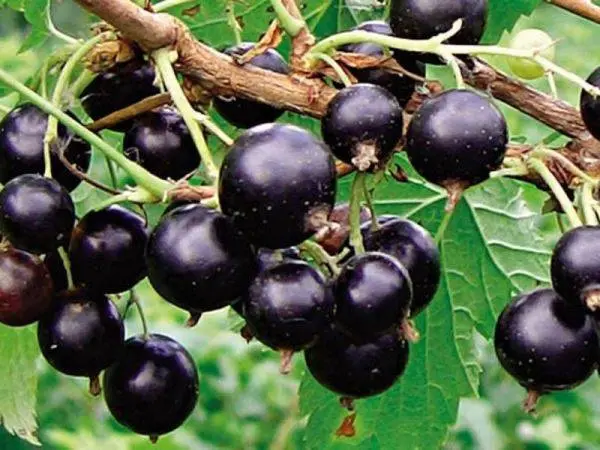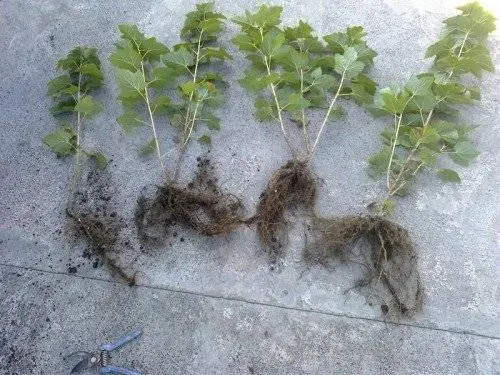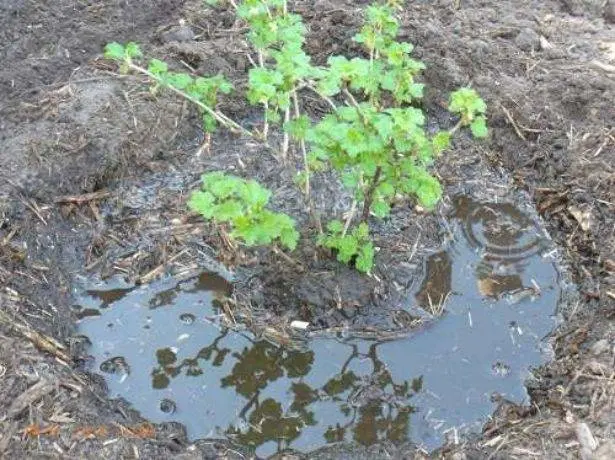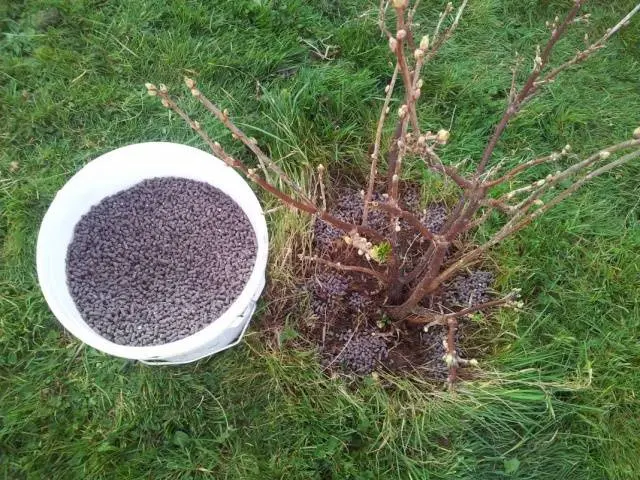Breeders have bred many varieties of blackcurrant, differing in yield, bush structure and other characteristics. Berries contain a lot of vitamin and are used even for medicinal purposes. Among the many varieties, blackcurrant Vologda has gained great popularity, the bushes of which withstand severe frosts, and in summer they delight with a plentiful harvest of delicious berries.
Main characteristics of the variety

A description of the Vologda currant variety, photos, reviews of gardeners will help to better study the culture. Let’s start the review of the characteristics with the structure of the bush. Currant grows with spreading branches. The bushes are medium tall and very dense. Shoots grow with a bent top. The skin is green. The bark of adult branches becomes gray with a brown tint. Five-pointed leaves on the bush grow in different sizes. The surface of the green plate is matte, a bluish tint is often observed.
The flowers are collected in clusters. The length of the brush reaches 10 cm. The shape of the flowers resembles a saucer. The petals are yellow with a clear predominance of a green tint. The stem is purple. A bunch consists of an average of seven berries. Large fruits are located closer to the base. The mass of the berry varies from 1,7 to 3 g. A mature brush acquires a rich black color. The shape of the berries is round, slightly oval. The pulp contains many seeds. The skin is strong with a slightly pronounced ribbing. A ripe berry is sweet, but acid is clearly felt. The pulp of Vologda currant contains vitamin C – 138 mg / 100 g and sugar – 8,1%.
Pollination can occur without the participation of bees, since Vologda blackcurrant is self-fertile. According to the ripening time, the variety is considered medium-late. The berries are ready to eat in early August. Brushes are able to hang on the bushes for a long time. Berries do not crack even when overripe. The yield of the Vologda variety is 4 kg per bush. Currant has good winter hardiness.
The advantage of blackcurrant Vologda are the following features:
- resistance to wintering;
- slightly affected by mites and powdery mildew;
- sweet large berries;
- stable yield;
- self-pollination;
- good adaptability to weather conditions.
Among the shortcomings of the Vologda variety, the large size of the bush is not comparable with the amount of the crop. The berries ripen unfriendly, which is inconvenient when harvesting.
Planting of seedlings

You can grow a Vologda blackcurrant variety in any area, even with poor soil. The shrub is unpretentious to special care. However, the Vologda variety has three worst enemies: a constant shadow, waterlogging of the beds, rocky soil.
Seedlings have been planted since October. If night frosts in the region begin earlier, then the dates are shifted to mid-September. A feature of blackcurrant is the absence of a dormant period in the root system. The Vologda seedling manages to take root in the fall, take root, and quickly grow in the fall.
In the spring, Vologda seedlings are planted from March to April. The earth should thaw, warm up a little. Buds on seedlings may be swollen, but not blooming. The site for blackcurrant is chosen raw, but not swampy. Usually Vologda bushes are planted in the lowlands, along the fences, but the place should be lit by the sun.
When buying, it is better to give preference to two-year-old seedlings of Vologda. The choice is made according to the structure of the root system. A good seedling has at least two lignified brown roots with many thin filaments. Dark color indicates hypothermia or drying of the root system. Such a seedling will disappear or take root for a long time. The age of two-year-old seedlings is determined by the length of the root system, which is at least 15 cm.
Seedlings 35 cm long with one or two shoots are considered good. The skin of healthy twigs is not wrinkled, brown in color without spots and mechanical damage.
When planting, observe the permissible distance between seedlings and other objects:
- Vologda bushes grow sprawling and take up a lot of space. The minimum distance between seedlings is 1,5 m.
- From the blackcurrant of the Vologda variety, you can make a hedge. If the bushes are planted along the fence, then they adhere to a minimum indent of 1,5 m.
- On large plantations, Vologda blackcurrants are planted in rows. Since the bushes grow strongly, the row spacing is maintained at about 2,5 m. The path is needed for caring for shrubs, watering and harvesting.
- Blackcurrant bushes can be alternated with fruit trees. The distance between young plantations is kept at least 2 m.
The rules for planting seedlings of the Vologda variety are the same as for other varieties. The whole process can be divided into several points:
- A plot for seedlings is dug up on a shovel bayonet. Remove weed roots, large stones and check acidity. If the indicator is too high, by 1 m2 scatter 500 g of lime, dig up and leave for a couple of days.
- Holes 40 cm deep are dug under each bush. The hole can be made square or round, with a diameter of 50 cm.
- Half a bucket of compost and old manure are poured into the hole. Organics can be replaced with a mineral complex containing potassium, phosphorus and other trace elements.
- The contents of the hole are filled with a bucket of water. After soaking at the bottom of the hole from the soil, they organize a slide.
- Currant seedling Vologda set at an angle of 45о. The root system is sorted out along the mound and covered with earth. The soil around the seedling is rammed by hand. This must be done carefully so as not to damage the root system.
- After planting, 4 buckets of water are poured into the hole. The Vologda seedling is cut with a pruner exactly in half. In currants with strong roots, it is fashionable to cut off 1/3 of the upper part. Pruning creates optimal conditions for strong growth.
- The place around the seedling is framed with an earthen embankment. The earth in the hole is covered with a thick layer of sawdust or peat mulch.

Marshy areas with a close location of groundwater can also be used for growing blackcurrants. Holes are not dug in such areas. After digging the earth and applying top dressing, wide mounds 25 cm high are made. Currant seedlings are planted on them.
The video talks about planting blackcurrant:
Features of care

Careful care of blackcurrants is required immediately after planting, so that the seedlings take root well and give a quick growth. If you continue to take care of adult bushes, the Vologda variety will thank you with a good harvest.
Currants need water as a source of moisture and as a preventive measure. In early spring, hot showers are given to the bushes. A bucket of water is heated to a temperature of 60–70оC, dissolve 250 g of baking soda, pour into a watering can and irrigate the bush. A hot solution is safe for currants, but destroys wintering pests on branches.
Currant Vologda loves moisture, but frequent watering is not needed. Dampness is sufficient inside the soil. Watering can be increased in dry summers, when cracks appear on the ground from intense heat. A deep depression is raked under each currant bush and up to 6 buckets of water are poured. The earth should get wet to a depth of 40 cm.
Mandatory watering is carried out in the following cases:
- in the spring before bud break, if the weather is dry;
- during flowering and pouring berries;
- dry summer;
- in the fall, when the currant sheds its foliage.
Many gardeners resort to the simplest method of watering – sprinkling. Sprays of water well wash off dust from currant foliage, but strongly compact the soil. For uniform and deep absorption of moisture, grooves 10 cm deep are cut on the soil surface in the intended zone of the roots.
A good effect is obtained from a stone well. I dig a hole 40 cm deep and 25 cm wide under a blackcurrant bush. Large stones are thrown into the hole. During irrigation, water quickly passes through the stones and enters the roots. From above, a stone well is covered with a piece of tin or roofing material to prevent moisture from evaporating.

Soil care includes loosening, weeding, adding wood ash and mulching. Good blackcurrant Vologda responds to top dressing. Fertilizers are applied in the third year after planting a seedling:
- in the fall, after dropping the leaves under the bush, 3 kg of organic matter is added;
- mineral fertilizers are added annually along with organics: 30 g of nitrogen and phosphorus, as well as 15 g of potassium;
- while pouring berries under a bush, potassium dissolved in water is added – 10 g and superphosphate – 40 g;
- in spring, during flowering and after harvesting, currants are fed with urea at the rate of 40 g per bush.

The first pruning of a young seedling of Vologda is carried out immediately after planting. By autumn, five shoots about 45 cm long should grow. The following year, a new growth will begin. Old branches will give birth, and only strong ones leave new shoots. All weak branches are pruned. In the third year, last year’s shoots become fruitful. Old branches also bear fruit, but in the fall they are pruned. A further pruning cycle is repeated annually. An adult, normally formed bush should consist of 10-15 fruit branches.
The video tells about the autumn pruning of currants:
Reviews
There are a lot of reviews about the Vologda currant variety. Let’s read some interesting opinions of gardeners.









